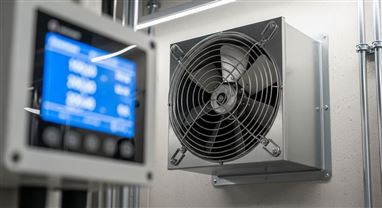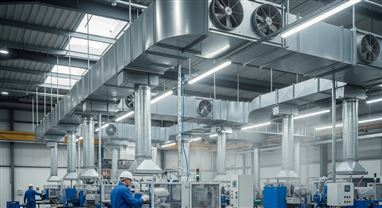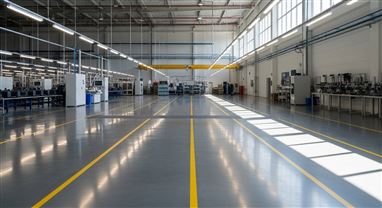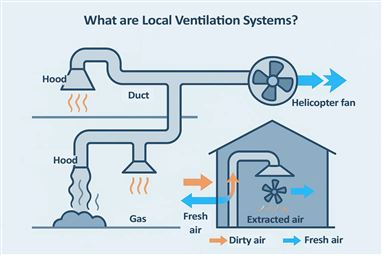Establishing regular and cross ventilation and quickly exhausting humid indoor air with large ceiling fans maintains moisture balance; when low wall grilles, roof openings, and—when needed—humidity-sensor automatic fan control are used together, the result becomes even more long-lasting. In this way, feed and bedding do not mold, respiratory diseases in animals decrease, and the risk of slipping on floors is reduced.
Getting to the root of the moisture source is the second step. It is necessary to repair leaks in roofs and gutters, create robust drainage channels that prevent water ingress, and form sloped floors to prevent the accumulation of manure and urine. At the same time, by changing bedding frequently and drying overly wet areas with sawdust or lime, the vapor load in the environment is reduced.
Finally, taking humidity measurements morning and evening and including additional measures in the routine when values rise should be standard practice. Choosing white roofs that reflect solar heat while bringing in cool night air in summer, and limiting the indoor-outdoor temperature difference with good insulation and controlled heating in winter prevents humidity from rising again. Sustaining this system with regular maintenance and measurements ensures the barn remains dry and healthy throughout the year.
What Causes Moisture in Barns?
The source of humidity in barns most often arises from the combination of outdoor conditions and imbalances indoors. While animals’ respiration, urine, and manure already generate constant moisture, structural issues such as poor ventilation, rainwater leaking from roofs, and inadequate floor drainage prevent that moisture from being expelled. When steam has no way out in closed systems and bedding remains wet, the air becomes increasingly heavy, negatively affecting both animal health and overall hygiene levels.
Main causes of barn humidity:
- Insufficient or improperly positioned ventilation systems
- Inadequate indoor space and air circulation relative to animal density
- Vapor produced by urine and manure accumulating on the floor
- Wet bedding and undried areas around feeders
- Lack of drainage or blocked water channels
- Rainwater leaking from the roof, walls, or windows
- Condensation and dew accumulation during seasonal transitions
Humidity resulting from these causes will, after a while, degrade the overall air quality of the barn. Damp stains begin to appear on walls, floor slipperiness increases, and respiratory ailments for animals become inevitable. In systems lacking regular maintenance, unpleasant odors, bacterial growth, and productivity loss are added to this picture. Therefore, it is not enough to simply remove moisture; it is necessary to understand why it forms and implement a solution for each cause.
Ideal Ventilation Systems for Moisture Control
A combination of cross and tunnel ventilation forms the backbone of moisture control in barns. When large intake vents installed on the inlet wall work together with high-flow axial fans positioned on the outlet wall, the heavy, moisture-laden air inside is expelled within minutes. Large-diameter, slow-rotating ceiling fans mounted in the roof void keep airflow at animal level and help vapor from the floor rise to the ceiling, so feeders and bedding begin to dry.
For the system to operate efficiently, the air changes per minute must be calculated according to the number of animals and the volume of the pen; vents should be equipped with adjustable louvers that prevent excessive wind ingress. Among the common mistakes seen in modern farms are placing fans at incorrect heights and restricting the outlet area. With correctly aligned fan arrays that circulate air around the entire space, mold caused by moisture, ammonia buildup, and odor complaints decrease significantly.
Sensor-based automation supported by smart control panels continuously monitors humidity percentage and temperature and engages fans in stages as needed. Energy-efficient EC-motor fans reduce electricity consumption thanks to variable speed control and operate quietly at night, keeping animal stress to a minimum. With regular filter cleaning, seasonal adjustment of vent openings, and annual airflow tests, this ventilation setup offers high efficiency and low maintenance costs over the long term.
Effects of HVLS Fans and Ventilators on Humidity
HVLS fans and high-power ventilators help keep the environment dry by rapidly dispersing moisture within the barn. These fans, rotating slowly but with a large diameter, create effective airflow from ceiling level down to the floor. Thus, humid air is carried upward, fresh air is brought downward, and this cycle both balances temperature and prevents condensation. Particularly in summer, when high humidity arises with animals’ perspiration, these systems remove it much more quickly.
Effects of HVLS fans and ventilators on humidity:
- Provide large-volume air circulation at low RPMs across big spaces
- Reduce condensation and sweating by carrying humid air upward
- Support faster drying of bedding
- Prevent the spread of unpleasant odors caused by ammonia and moisture
- Reduce heat stress in animals, increasing comfort
- Lower the risk of mold forming on walls and in roof corners
- Create a more stable indoor environment, supporting overall hygiene
Correctly positioned HVLS fans affect a much larger area than conventional fans and therefore become an indispensable part of moisture management, especially in large barns. When fan direction, speed, and activation schedules are precisely adjusted, the indoor moisture load drops noticeably. This delivers an improvement that directly impacts not only animal health but also the building’s lifespan and production efficiency.
The Relationship Between Heat, Insulation, and Humidity
In barns where heat balance is disrupted, the indoor-outdoor temperature difference rises rapidly, causing condensation on surfaces. Especially at dawn and dusk, metal roofs and wall surfaces condense evaporated moisture into water droplets. This moisture forming on floors and bedding directly affects animal health. In areas where temperature differences concentrate, both mold and bacterial growth accelerate.
In structures with improper insulation, this process becomes much more severe. Thermal bridges in ceilings and walls prevent warm air from being retained indoors and set the stage for humid indoor air to contact cold surfaces and turn into water. Particularly in areas lacking roof insulation, heat loss accelerates—leading both to increased humidity and higher energy costs.
In a well-insulated barn, heat is distributed more evenly, condensation does not form on surfaces, and airflow is dispersed in a controlled manner. Because heat loss decreases, indoor air quality is also preserved. This contributes not only to keeping humidity under control but also to animal welfare, productivity, and balanced feed consumption. In structures where heat and insulation are not considered together, humidity control becomes a constant problem and permanent improvements cannot be achieved with temporary solutions.
Benefits of Vapor Barrier (Anti-Condensation) Applications
When placed between wall and roof layers, a vapor barrier blocks the passage of water vapor, preventing dripping and mold on interior surfaces; thus, insulation materials remain dry, heat losses are reduced, and the lifespan of the structure is extended.
Main benefits of vapor barrier applications:
- Prevents condensation, stopping metal corrosion and wood rot
- Maintains the thermal resistance of insulation, reducing energy expenses
- Eliminates the moisture required for mold spores and bacterial growth
- Lowers ammonia concentration that irritates animals’ respiratory tracts
- Helps floors and bedding dry faster
- Reduces maintenance frequency and repair costs
- Minimizes temperature fluctuations inside the barn, increasing comfort
During installation, laying the barrier continuously, sealing joints with vapor-tight tape, and fastening in a way that avoids creating thermal bridges ensures lasting success. Supported by regular ventilation, this system addresses moisture-related problems at their root while safeguarding both animal health and operational efficiency.
How to Measure and Monitor Humidity Levels
Digital hygrometers and wireless humidity sensors should be used to measure humidity levels accurately. These devices provide the instantaneous humidity ratio as a percentage, and most models make tracking easier with daily or weekly change graphs. Placing multiple sensors in different areas of the barn helps identify zones where humidity is not distributed evenly. Taking measurements especially from corners and under-roof spots where airflow is weak plays a critical role in getting to the source of the problem.
The monitoring process should be regular and systematic. Humidity measurements should be taken at the same times every day, and the data obtained should be recorded. Measuring temperature along with humidity yields more accurate results, as humidity varies depending on heat. Although ideal values vary by animal species in the barn, a range of 60% to 70% is considered healthy in most cattle barns. When these thresholds are exceeded, rapid intervention is required.
By monitoring data digitally, ventilation systems can be engaged automatically and the humidity ratio can be reduced. In addition, by making periodic comparisons, it becomes possible to take precautions against seasonal changes. This tracking habit positively affects many production parameters—from feed efficiency to animal health—not just comfort. Controlled environmental management directly boosts operational efficiency.











Leave a Comment